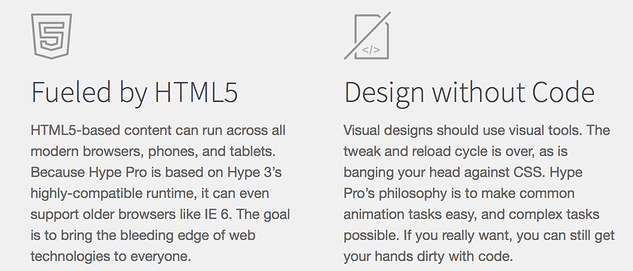The following is in the spirit of the proverbial intellectual discussion. (I lived among the Brits for years and I learned to really enjoy a good back-and-forth. This is because it’s not about winning a debate but rather because the product of the exchange – which ever way it may go – can be very informative for all involved.)
There are several other points that might be relevant to the discussion:
Is Hype a creative app for scripters/programmers or is it a creative app that offers excellent support for scripting?
Clearly, Hype was developed by scripters/programmers and not creatives, so it would obviously be intended for and seen by the creators as the former. This being said, I wonder what is the ratio of Hype users between of creatives and scripters/programmers? Do the JS users of Hype outnumber the creatives?
My guess is that by some degree the creatives (including those who want to develop their JS skills) outnumber the others. Coming from a creative background, I would describe Hype not as a programming app for producing interactive animations, but as being a creative app for producing interactive animations. This is because one could postulate that at its most basic level, Hype is a visual communication app.
As for being friendly for those with a strong web background and for following the norms, I definitely see your point. This being said, there are many things that people do on the web that were not in the original spec.
I tend to take a right-brained approach to finding balanced solutions. If this approach were taken, I would suggest that the ideal all-round solution would be setting the external measurement of a stroke / border as the default, while also providing the option for center / inside.
As leaving things at the default would require absolutely no action on the part of the scripters/programmers/web folk, this would make it a non-issue, while having the other two options would work best for the creatives.
At the risk of being slammed as an anti-establishment Picasso / Dali / Warhol freak, I come from a background where overcoming theoretical barriers is like E E Cummings overcoming punctuation. It is a background where pushing an app beyond its intended limits is a great way to make an impact on the masses.
The hassle of programming this feature aside, I don’t see it as a revolutionary notion. Most creators of visual content in the world are not scripters but creatives (probably a ratio of at least 50 to 1). Recognizing that the shift is towards the web, and seeing that more and more creatives are learning to code and script, I would think that tossing this kind of a bone to the creatives would be reasonable.
Naturally, my view of things is influenced by my personal experience and background. One thing that I see from my years in marketing departments for consumer goods and services is that, if forced to make a choice, most companies in that category would choose a creative with web skills over a web person with creative skills. This is based on the notion that marketing is more about the visual and affective appeal than about appealing to the intellect. (Think about every print ad, web ad, and TV spot you see on a given day. Affective rules. Even so, the cleverness of what is presented is what pushes it over the line, be it achieved through visual design or scripting.)
This goes back to a restating of the previous question: Where are the majority of Hype users coming from - creative or back-end? It would be interesting to find out.
It would also be good to hear arguments against this position. No doubt, creatives like myself would learn something.


 .
.